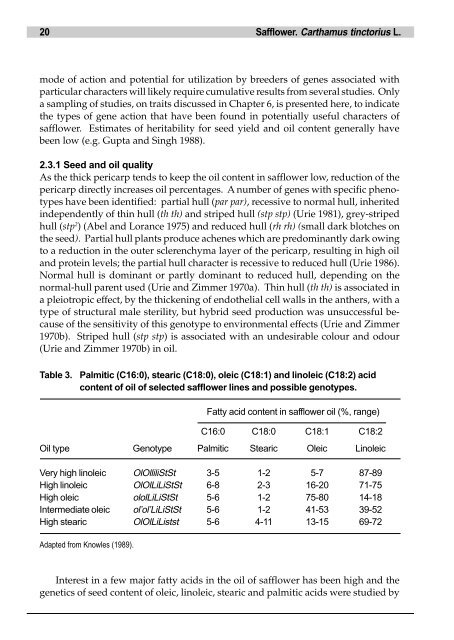Safflower, Carthamus tinctorius L. - Bioversity International
Safflower, Carthamus tinctorius L. - Bioversity International
Safflower, Carthamus tinctorius L. - Bioversity International
Create successful ePaper yourself
Turn your PDF publications into a flip-book with our unique Google optimized e-Paper software.
20 <strong>Safflower</strong>. <strong>Carthamus</strong> <strong>tinctorius</strong> L.<br />
mode of action and potential for utilization by breeders of genes associated with<br />
particular characters will likely require cumulative results from several studies. Only<br />
a sampling of studies, on traits discussed in Chapter 6, is presented here, to indicate<br />
the types of gene action that have been found in potentially useful characters of<br />
safflower. Estimates of heritability for seed yield and oil content generally have<br />
been low (e.g. Gupta and Singh 1988).<br />
2.3.1 Seed and oil quality<br />
As the thick pericarp tends to keep the oil content in safflower low, reduction of the<br />
pericarp directly increases oil percentages. A number of genes with specific phenotypes<br />
have been identified: partial hull (par par), recessive to normal hull, inherited<br />
independently of thin hull (th th) and striped hull (stp stp) (Urie 1981), grey-striped<br />
hull (stp 2 ) (Abel and Lorance 1975) and reduced hull (rh rh) (small dark blotches on<br />
the seed). Partial hull plants produce achenes which are predominantly dark owing<br />
to a reduction in the outer sclerenchyma layer of the pericarp, resulting in high oil<br />
and protein levels; the partial hull character is recessive to reduced hull (Urie 1986).<br />
Normal hull is dominant or partly dominant to reduced hull, depending on the<br />
normal-hull parent used (Urie and Zimmer 1970a). Thin hull (th th) is associated in<br />
a pleiotropic effect, by the thickening of endothelial cell walls in the anthers, with a<br />
type of structural male sterility, but hybrid seed production was unsuccessful because<br />
of the sensitivity of this genotype to environmental effects (Urie and Zimmer<br />
1970b). Striped hull (stp stp) is associated with an undesirable colour and odour<br />
(Urie and Zimmer 1970b) in oil.<br />
Table 3. Palmitic (C16:0), stearic (C18:0), oleic (C18:1) and linoleic (C18:2) acid<br />
content of oil of selected safflower lines and possible genotypes.<br />
Fatty acid content in safflower oil (%, range)<br />
C16:0 C18:0 C18:1 C18:2<br />
Oil type Genotype Palmitic Stearic Oleic Linoleic<br />
Very high linoleic OlOlliliStSt 3-5 1-2 5-7 87-89<br />
High linoleic OlOlLiLiStSt 6-8 2-3 16-20 71-75<br />
High oleic ololLiLiStSt 5-6 1-2 75-80 14-18<br />
Intermediate oleic ol’ol’LiLiStSt 5-6 1-2 41-53 39-52<br />
High stearic OlOlLiListst 5-6 4-11 13-15 69-72<br />
Adapted from Knowles (1989).<br />
Interest in a few major fatty acids in the oil of safflower has been high and the<br />
genetics of seed content of oleic, linoleic, stearic and palmitic acids were studied by

















